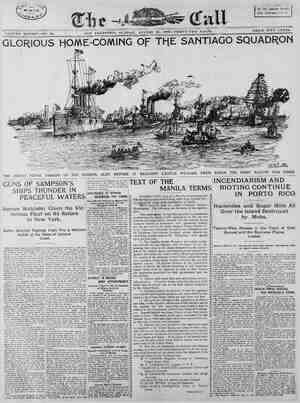The San Francisco Call. Newspaper, August 21, 1898, Page 23
You have reached the hourly page view limit. Unlock higher limit to our entire archive!
Subscribers enjoy higher page view limit, downloads, and exclusive features.
THE SAN FRANCISCO CALL, SUNDAY, AUGUST 21, 1898. 23 Battleships as Oold by Special SPhotographs - - - WRECK OF SPAIN'S CRACK BATTLESHIP, THE VIZCAYA. S T R T T R BT S M Y R ) O B % & No Words Could So Eloquently Convey the Effects of a Heavy Storm of Modern Naval Projectiles as These Photograp! S CopymicHT 198 B¢ JAMES SoRDom BENNETT OoF PROTECTED > s \ EXPLOSION OF AFTER MASAZW™B TIFTING UP oF DECK REAMS BY EXPLOSION OF AFTER MASAZING at work on the number of 1 power- esa IS accompl an The pontoons N ts placed in T each side of must now kb sweep chain ' small chain wh mud and_debris point under the lifting chains are T to pontoon. Santiago. her and pontoons, to tow > bottom to a ere the main ed from pontoon taken show that her position i 1den storm from the south will ha tendency to arther up on the beach, a con- that will render the work of - Soundings which i n. Chs until there are o answer the purpose, preliminary task is by no means e as the masses of debris which the hull ally accumulate upd and ofte the American flag time. plan formulated by structor Hobson, and heartily approved n place, pass up the the pontoon decks where there are certain toggles ar- ranged for controlling them. Thess chains are immense affairs, and the alls for the use of pontoons utmost care s taken in their manu- r facture. Cases have occurred where defective links have been ““c means of wndoing in one moment the work of weeks. In righting vessels on their beam finally i pontoon wells to it The air bag idea is compa new; but the use of pontoors is atively an old LIETING OF SPAR DECK BY EXPLOSION FORwasc From Photographs Taken Specially for the Sunday Call hs of the Splendid Ship That Was Once Spain’s and Now Is Ours by Right of Conquest. pects of the Same Ship. .fid‘&."&.fi—*.fi.fi#.fi'.fifi.fi&&d‘fi All the Pictures on This Page Are Different As- VIZCAYA , STARBOARD STDE B Y JAMES Gombor ends the process known as parbuckling is generally used. The chains are assed from the pontoons vertically ownward and completely under the side of the hull which touches the shoal. Then they pass upward by the keel, are led over the opposite side, and are then attached to some object on the wreck, such as the mast or superstruc- ture. When the tide is out the slack on the chains is taken in, and the énds, are D d. FTARBOARD $1DE SHOWING INTERNAL TORPEDOEXPLOSION securely fastened to the pontoons. If everything works well, if the chains safely stand the strain, if the mast or superstructure does not give way, then the rise of the tide will cause the hull to be gradually lifted until she stands on an even keel, This much accomplished, prepara- fons are made to float the wreck. Infthe ase of the Colon, divers will be utllized to place the empty air bags in tha lawer EFFECT OF SHOWING HOLE i.Bow Bown ShAaL Passeo THROUGH (PosT HEaD is supposed to be decks. Each bag As the capable of lifting thirteen tons. Spaniard was a heavy ship, a great number of these, in addition to the pon- toons, will be needed. The placing of the bags is not a difficult task as a rule, but due attention must be paid to the tide on the Cuban coast and to the fact that- the spot is entirely open to the sea and the sweep of - the southern winds WHERE. PORTION SHELL 3TRUCK ATVTER. ness were used on the pontoons. When the chains were in place the pontoons were pumped full, then, as the latter sank the slack of the chains was hauled in and made fast. The moment the pumping out began the lifting power of the pontoons became appar- ent, and the buoyancy of the six pon= toons slowly but surely overcame the wreck’'s weight. In 1884 the wrecking company now engaged on the Spanish vessels raised the United States steamship Talla- poosa, sunk by a coal schooner in Long Island Sound. Pontoons were used, and in a remarkablv short space of time the old gunboat was lifted, pumped free from sand and water and gent under her own steam to the Brooke ya Bavy-yasds A better understanding of the work necessary in raising the Colon can be obtained from a description of the wrecking of the Wells City, an English steamer of 2000 tons, which was sent to the bottom of the North River by a collision with the American steamer Guyandotte. The same company now working on the Spanish warships raised the Wells City, and the same system of pontoons was used. The three pairs of pontoons employed then had a greater raising capacity than the tonnage of the steamer. This was rendered necessary by the fact that there was eight feet of water over her deck, and a considerable amount of de- bris and sediment which had accum- ulated by the action of the river's cur- rent. Powerful chalns of three-inch thiclk-
